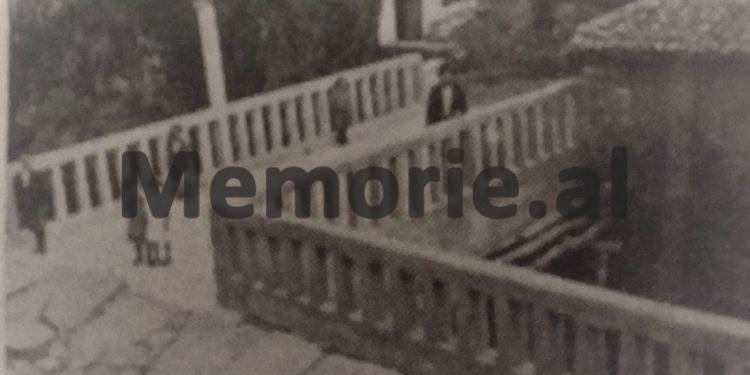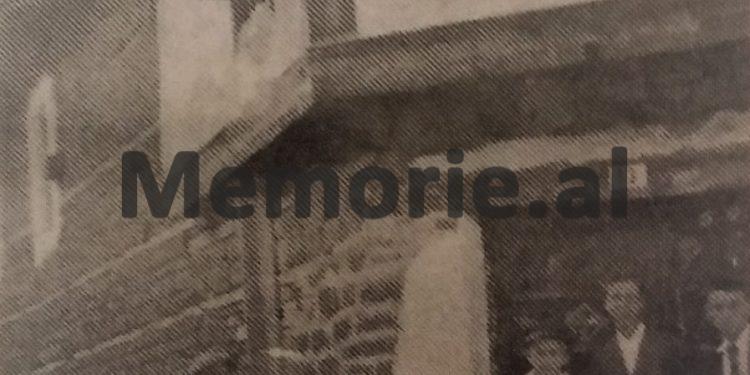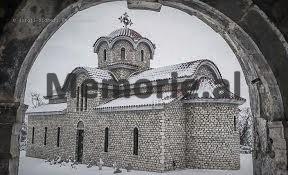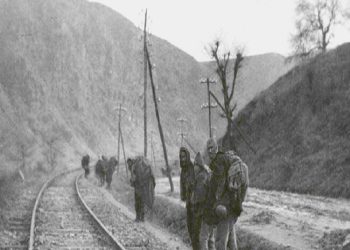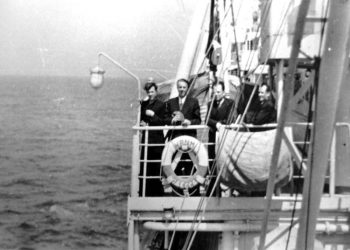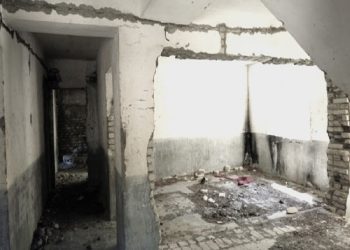Dashnor Kaloçi
Memorie.al publishes the unknown history of the villages Drenovë – Boboshticë of Korça district which are located at the foot of Morava mountain only 8 km. away from the city, which, not only for their picturesque nature and ancient history (according to the renowned scholar, Prof. Dr. Sotir Temo, dates back to the 11th century), but also for the wise people who have drawn from decades ago, like; Viktor Eftimiu, Kristaq Antoniu, Sotir Kuneshka, Dhimitër Canco, etc., names and famous personalities artists, writers, scientists and prominent intellectuals of various fields, has aroused the curiosity of many foreign visitors and scholars from distant Europe, such as the Frenchman, Andrea Mazoni, who visited him in August 1936, even writing two books, (‘Dokuments Contest et Chanson Slaves De L’Albania Du Sud’) only about Boboshtica and her wise men. As well as the unknown writing of Themisto Dodonari in August 1945, entitled “Two academic communications in the village of Drenovo” and subtitle “The foundation of a historical archive of the villages Drenovo – Boboshtica”, where he describes some cultural and artistic activities developed in those villages with a big name, even outside the borders of Albania.
Not only villages, but even many cities in Albania would envy Boboshtica, the village located at the foot of Morava south of the city of Korca. The big village, or small town as it is rightly called the ‘blessed place’ that is located about 8 km. away from Korça, with the picturesque nature that winter adorns the snow-white ‘mantle’ under the golden rays of the sun that shine far and wide from Gramoz to Malë Thatë, for the wise people it has produced since the beginning of the century past, has piqued the curiosity of many scholars since Far Europe. Many artists, writers, scientists and intellectuals of various fields, such as Viktor Eftimiu, Kristaq Antoniu, Sotir Kuneshka, Dhimitër Canco, etc., names and well-known personalities who have become famous not only in Albania but also abroad, will to make Boboshtica “measured” and with many of the big cities of our country, feeling many times “bigger” than them! But what is this village, since when are the beginnings of its knowledge and who are the wise people that the famous Boboshtica has produced?
Boboshtica in the study of Prof. Dr. Sotir Temo!
Boboshtica today has close to 300 houses and the village is located between four hills. Well-known Prof. Dr. Sotir Temo, in one of his studies, says that Boboshtica in the XVIII – XIX century, had gained some independence and self-government. From a manor under the rule of Ali Pasha Tepelena (1817) and later of the Sultan, he escaped from this yoke, paying 6,555 Turkish liras. At that time, the village was renovated starting the arrangements from the town planning. Cobblestone village roads were paved, bridges, canals, water taps and two fountains were built. Lands and meadows as well as pastures remained common. Particular care was taken for both schools, for girls and boys. Of the many churches located there, one of which is that of St. John, dates back to the 11th century. There are also two monasteries, that of St. Mary at the head of the village and that of St. Kolli in the southeastern part, at the foot of Morava which is built in the time of Skanderbeg (1450). In this monastery was found one of the oldest icons in the district of Korça. This village was administered by an elder elected by the villagers themselves, in open meetings. There was an intense community, religious, but also cultural life that pervaded the entire village, almost all year round. Family and tribal holidays, especially religious ones, gave a great vitality to life in this village that often attracted many young people from the city of Korça. A special place in the whole life of this village, culture, customs, traditions, welfare and education, would be occupied by emigration, both East and West, from Romania to France. At the beginning of the last century, many villagers from Boboshtica would move to Romania, where they created the first Albanian diaspora by settling in Pietsh, near Bucharest.
Andrea Mazoni, French researcher in Boboshtica!
As we said above, from the beginning of the last century when the Boboshticars moved from the land of the ancients and settled in Pitesh, Romania, and until the middle of this century, many others from this village beat the curve for work, but also to be educated in Eastern and Western universities. After the opening of the French Lyceum of Korça, in the early 1920s, which was attended by a large number of children from Boboshtica, some of them continued their education in French universities. In the group of the first students who started classes in France, where most of them were from the city of Korça (students of the French Lyceum), from the village of Boboshtica, there was the student Gjergji Canco. In the student districts and those of the Albanian economic emigration of Paris and Montpellier, the well-known French scholar Andrea Mazoni, came in contact with them and showed great interest in Albania. In these meetings with the Albanian districts of France, for his own research work, Mazoni presented great interests for the village Boboshtica, which he decided to visit as soon as possible. Thus, his interest in Boboshtica, Andrea Mazoni made a reality in August 1936, as he left the city of Bari in Italy, to arrive at the small port of Durres, with a small transport ship. In this village, Mazon stayed for about three months, feeling the unstinting hospitality of the Boboshticar villagers, who amazed his distant friend from France. Amid the warmth of the generous people of that village, Mazon was well known for those three months, from their language and customs, to their culture that left nothing lacking even to the most famous villagers of the west. After returning to his homeland, Mazon would greatly increase contacts with students from Boboshtica, studying in Paris and Montpelier, such as Sotir Kuneshka and Gjergji Canco, asking for their help in many things that he would need. in the compilation of two voluminous books only for Boboshtica.
Two voluminous books about Boboshtica by Andrea Mazoni!
After returning to France, Andrea Mazoni started working and wrote a book only about Boboshtica, entitled “Dokuments Contest et Chanson Slaves De L’Albania Du Sud” (Par. Andre Mazon Professeuer Au College DE France). In the preface of this book, which Mazon published in 1936, among other things, he tells about his knowledge of Boboshtica, through some foreign scholars, such as AM Selichev from Bulgaria, who in 1931, had published in Bulgaria the study book, “Slavyansko e Naselenie – Albanii, Sofia”. Also, before this book by the Bulgarian author, who dealt with the study of Slavic languages in the Southern Balkans, Mazoni had known Boboshtica since 1923, through M. Naci’s book “Korça and the villages of the region”, which was published in Korça. In the study book for Boboshtica, although his aim was for the Slavic languages in the Southern Balkans, Mazon would dwell for a long time only on the Boboshtica people, in their customs, language and customs, from the very beginning when the village was established a few centuries ago… One of the things that impressed Mazon the most in his book about the Boboshticars, was their desire for knowledge and education, where many of the boys of this village since the last century, had crossed the borders of East and West, to was educated at universities in Europe and North Africa. One of the first characters of Mazon in his book, is Dhimitër Canco from Boboshtica, or as he was called and known by the Boboshtica “Dhaskali”. Dhimitri was born in 1814 and was known as the “Great Man” of Boboshtica. He had studied and graduated from the Lyceum of Constantinople, one of the most famous of the time. Dhimitri returned to his village when he was 30 years old and stayed there until he was 90 years old, when he passed away, working for almost half a century as a “dhaskal”. In his youth, Demetrius had emigrated to Romania, together with his fellow villagers, and had returned again to his native village. He was a lively man who was respected by all his fellow villagers. “Dhaskali” spoke several foreign languages, such as: French, Slavic, Romanian and Greek. Dhimitri died in 1904 and Andrea Mazoni through his descendants, as Gjergji Canco, a student in Montpelje, used many of his (Dhimnitri) memoirs for his book on Boboshtica. In his book, Mazoni talks and thanks for the help given to him during the study expedition in Boboshtica and Drenovo, the Ministers of the Royal Government, Dhimitër Berati and Myfit Libohova, as well as the Prefect of Korça, Ismet Kryeziu. About 50 years after the publication of the first book, in 1965, Mazoni published another book about Boboshtica, this time together with his colleague, Filipova Bajrova. In the preface of this book, Mazoni and his colleague Filipova, thank and point out for the great help they have had for the drafting of the book from the memoirs of Dhimitër Canco, Pope Teodor Ikonomu, to those of Stilian Eftimiu, Sotir Kuneshka.
Two academic communications in the village of Drenovo!
The villages of Boboshtica-Drenovo and their history and the wise people that that village brought out, continued to be talked about even after the end of the War and one of them was Themisto Dodonari, who in his article dated August 7, 1945, entitled “Two academic communications in the village of Drenovo”, and the subtitle “The foundation of a historical archive of the villages Drenovo – Boboshtica”, among others wrote:
On the occasion of a visit to our village, on the 6th day of August – the 1st Ekremte of St. Sotir – in the beautiful “Nasi” garden, Ilo Mitka Qafëzezi, made two literary, academic, very important communications for the history of the villages Drenovo – Boboshtica, as well as for the historiography of Korça in general. The singing elders of the village, members of the N. Liberation Council, the educational body and many others took part in this story.
After the presentation by comrade Tushi Dodana – Drenova, Qafëzezi showed to the villagers two cartoons of the archive of his “Institute – Nucleus”, this year’s literary act-visit, which belong mainly to the common history of the villages Boboshtica – Drenovo. It is about two condos of historical monuments Drenovaro-boboshtari, which bear the numbers 48 and 283, of the Catalog Qafëzezi, of the Manuscripts, entitled “Dhaskal Condition Dhimitër Canco Boboshtiri”, and of the Family Archive Thodhoraq Dh. Canco of Boboshtica, and “Kondiku Dhaskal Dhimitri Verdho” (or Verdhi) of the Elders Archive of the village of Drenovo. To these, adding to each of a second treasury of relevant historical documents, from the Metropolitan of Korça, from the archives of the Albanian societies of Bucharest, etc.
Qafëzezi is giving the destiny to constitute the precious stone of the foundation of a historical archive, common, of the villages Drenovë – Boboshticë, with an Efori of 6 people, from three from each village. With the efforts and cooperation of the N. Çl Councils, of both villages, of every intellectual of these, in the Motherland and abroad, the cartoons will be continuously enriched with all their most recent historical events, as well as with the biographies of all men. distinguished as educational, social benefactors, etc. Until the thirty-fourth of the Movement N. Çl. of Albania.
Qafëzezi, after giving it to be understood, (with living documents saved from the backstorms), that not only the cities but also every village of Albania, with an effort of fellow students, can agree with a History of his own – starting from a village horography: the neighborhoods, any river that flows through it or the districts, let the fields, etc. Around and beyond with their toponymy, schools, churches – mosques, the benefactors of these, adorned with all the folklore that pertains to the founding of the village, legends like that of Tomor’s quarrel with the Shpirag of Berat, etc. Made a brief description of the “Dhaskal Condition Dhimitër Canco” as follows:
1.The writer divides his historical monument into two parts, after the first delicacy, which takes the place of the title, with the words: in the days of… Sultan Aziz in 1874…”.
The first part contains a preface by which Dhaskal Dhimitër Cancua tells us that the main impetus for writing this work came from the events of the disintegration of Imlaq, namely the repurchase of the village and the secession from his regime as State Estate (Imlaq – State property). Based on two valuable historical legends, which he gave in Bucharest in 1840, Arkond – Pitari Jovan Simo Gjerasi – Boboshtari, the nobleman of Vojvoda Aleks Gjikë – Allbanez (the first Domnitor reglementary of Muntenia, with the capitals of Bucharest, a man and patriot ”, conf. Dict. Saineanu p.905), says that both of these villages, rooted here, for a long time unknown, are by some Bulgarians“ servants of the Byzantine emperors, expelled for political faults ”, or, according to a folk tale, from the waves of dense Bulgarians in these places, from North to South ”.
Entering his main topic, Dhimitër Cancua beautifully shows us the political reasons of the time when, Drenova before and Boboshtica after, are forced to submit to “Imlaqëra of Ali Pasha satrap of Ioannina”, in the years 1814 and 1817, of the evil blacks removed by the “Spaniards and Imlaqashins” (1818 – 1874). In many chapters (IV-XIV) of pages 27-126, we are given a detailed and repeated description of five times the “efforts for liberation from Imlaq”, with reference to: the initiative and noble efforts of the patriot Bujer Simo Gjerasi – Boboshtari, fled this village “childishly, from the chaos of time”. It is worthwhile to make a fourth attempt, for the joint liberation of both villages, from the side of Korça “Petro A. Kunxho (Kujundxhiut Drenovarit), who with his rare skills” made a British sub-consulate in Korça, under Consul Sir Xhorxhaqi”, etc.
The fifth and final attempt is what two village intellectuals make: Themel Sotir Kuneshka and especially their son, Ligor Themeli, with the writer Dhimtër Canco. The projects of these two, submitted through correspondence Korça – Boboshtica, bring to light the ardent desire for the liberation of Drenovo – Boboshtica “from the blacks of the Imlaq lav slavery with the mercy of the mercenary Sultan Aziz”. The sufferings of these, by the Ottoman government, etc. Up to the back wash of the immoral accounts, described there with all the hints, are a real calvary.
In chapter XIV of this historical monument, a description of the village of Boboshtica is made – “town” – “town”, says the old conic – with Slavic toponymy, etc., as well as with this important chronicle: “Above the river or stream” “Turkey is a bridge with a thin spire, which was built in 18… (as) with the demolition of the math benefactor of the town of Qir Nikollaq Jovan Gjerasi, Vulefti (MP) in Bucharest”.
The second part of Kondik Canco, of great historical importance and this deals with the biographies of the most prominent men of the thriving village and with the Albanian chronicles of Korça, Boboshtica and Dardha ”./Memorie.al





